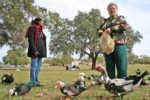A duck tale

As two women approach the lake next to the Fine Arts building every morning, flocks of ducks waddle as fast as they can to greet them. Sheila Mitchell does a duck call while she and Henrietta Glow distribute cracked corn to the rustling ducks quacking at their feet.
“She sounds just like a mama duck,” said Glow.
“Sometime I don’t even have to call them,” said Mitchell. “One of the ducks goes ‘They’re here! They’re there!’ and the rest follow.”
While Mitchell and Glow distributed cracked corn to the ducks below them, they chuckled about ducks they’ve fed in the past at the lake.
“When I first came, there was a duck that was a Peking/Mallard mix. We couldn’t tell if it was a boy or a girl so we called it Hermaphrida,” said Mitchell.
For the past five years, Mitchell and Glow – employees of Educational Outreach Classroom Services at USF – have been hand feeding the ducks at the same lake. They come to feed the ducks almost every weekday, usually in the mornings.
Glow explains that feeding the ducks is a relaxing break from her work schedule.
“It’s a de-stress trip we take… It makes you feel good,” she said.
“We try to come out everyday,” said Mitchell. “We take 15 to 20 minutes every day… Some days it’s just a relief to come out… Hanging out with the animals is less complicated than hanging out with people.”
Mitchell and Glow feed the ducks not only for relaxation, but to ensure that the ducks get a proper diet.
“I started feeding the ducks because people feed them so much garbage… I saw the kind of stuff people were feeding them and it wasn’t healthy…I wanted to make sure they had something nutritious,” said Mitchell.
Most people feed the ducks bread and that’s bad for the birds, said Glow and Mitchell. They explained that bread has no nutritional value.
“Ducks will eat whatever you throw at them,” said Mitchell.
When people feed ducks bread, it can cause health problems because the food is too processed and provides few nutrients, according to the Audubon Society of Portland, Oregon’s Web site. The Society suggests giving ducks foods that align with their natural diet, like cracked corn.
Mitchell and Glow have done their research and now, only feed the ducks cracked corn.
“A 50-pound bag usually lasts us about a week and a half to two weeks,” she said.
There are three types of ducks that live at the lake: Muscovy, Peking, and Mallard. The Muscovy ducks are larger with a red wattle. Mallard ducks are the more common brown, black, and green birds and Peking ducks are all white. The area is also populated with cranes, fish, turtles and squirrels. Sometimes, hawks, seagulls and crows come to visit.
“The turtles come up out of the water and you can hand feed them,” said Mitchell. “There’s also a fish in there about four feet big, we call him Jaws. He’s not afraid of the ducks.”
“He’s as big as they are,” said Glow.
One of their favorite aspects about feeding the ducks is seeing young ducks grow up.
“The most fun is when we have baby (ducks),” said Glow. “We get attached but each day we’ll lose some to the critters.”
Baby ducks are prey to larger birds such as crows and hawks, and many ducklings do not make it to adulthood. When the crows come, they eat the baby ducks, said Glow. Ganders will have 20 or 25 ducklings born every season but are lucky if they can raise one or two.
Mitchell said that she carries little rocks to keep them from eating the babies, but she also lets nature takes its course.
“I do what I can to protect them,” she said. “I get so upset.”
They have nicknames for some ducks, based on personality and physical features. Pretty Girl is a beige Peking, Afflack is a white Peking and Gimp is a big Muscovy like Pecker.
“If you don’t pay him any attention, he’ll come up behind you and peck you,” said Mitchell of Pecker. “It doesn’t hurt.”
Mitchell and Glow also try to protect the birds from other people.
“I get really upset when people drive through really fast,” said Mitchell. “I think that’s how (the ducks) get hurt.”
Mitchell also gets upset when people bring their dogs and let them loose. She tells them there is a leash law, but she said they respond by saying the dogs won’t hurt anyone.
“These are the ducks’ homes. They should feel safe here,” she said.
After five years of feeding the ducks, Mitchell and Glow have become self-educated duck experts. Some information has come from researching on the Internet, but most knowledge is acquired from observation.
“I’d go and read up certain behaviors but a lot of it is just observing,” said Mitchell. “Muscovys can be exclusive, but the Pekings and the Mallards will mate.” Pekings usually have three to four mates, she said.
After five years of feeding the ducks, Mitchell and Glow have become very attached and developed a relationship with them – much like a person does his other pet.
“I think they like it when we talk to them, they wag their tails like a dog,” said Glow.
Mitchell, however, feels more attachment with a certain breed.
“I’m more attached to the Pekings,” she said. “Especially Afflack with her bad foot, she’s pretty vocal.”
Glow will be ready to retire in about four months. She said she couldn’t bear not being with the ducks anymore and will probably adopt some from a shelter and keep them at home as pets.
“I think I’m gonna go buy me some baby ducks,” she said.





